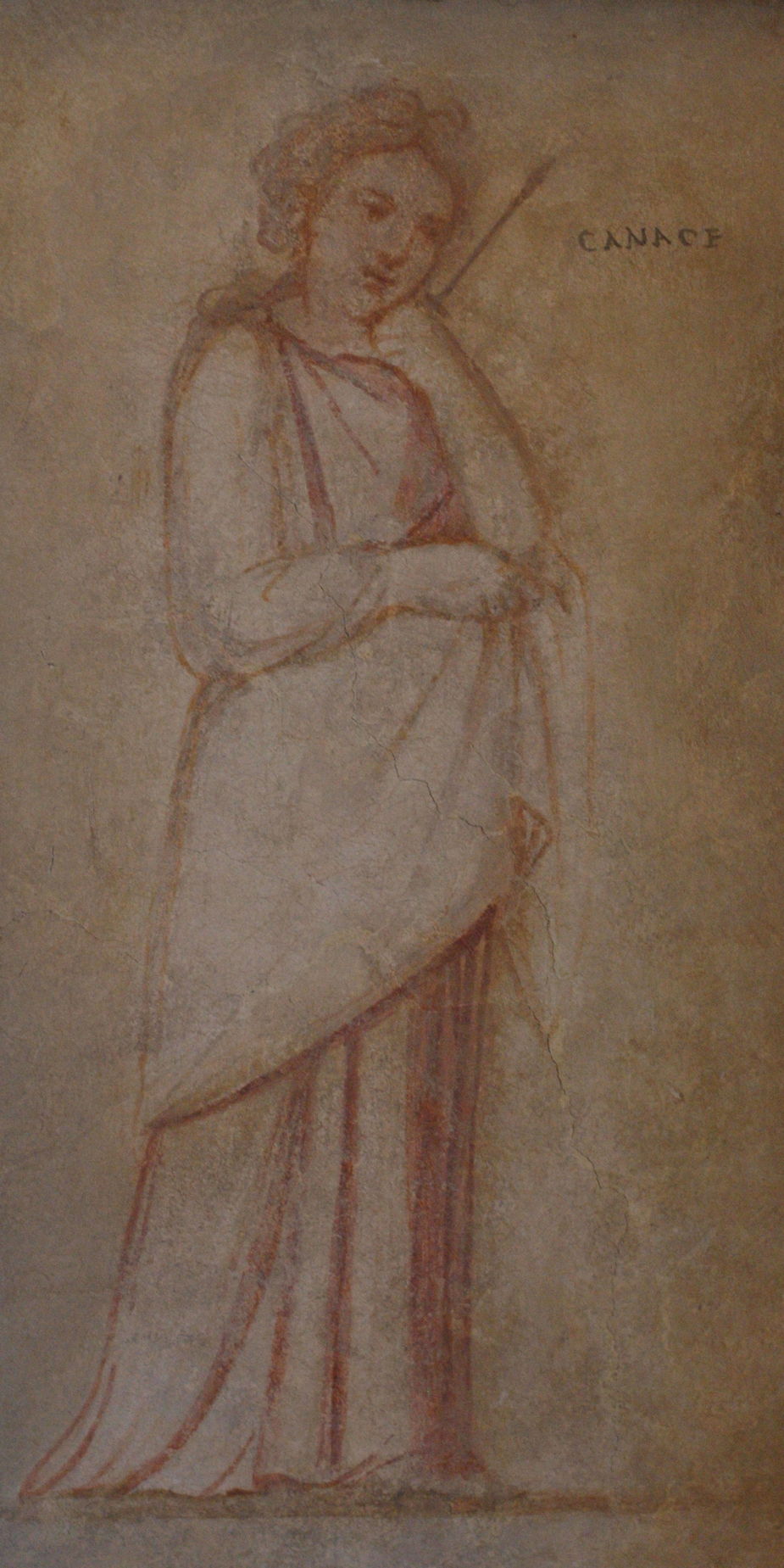In this, the last of my series about paintings of stories in Ovid’s Heroides, I cover the two stories for which there are almost no paintings at all. Thankfully, the paintings that I have found are both fascinating.
We start in the amazing collections of the Vatican. Known best for its most famous works like the ceiling of the Sistine Chapel, the Vatican Museums also hold some much more mysterious works. Among them is a series of full-length portraits in fresco which were found in a Classical Roman villa at Tor Marancia – now famous for its much more contemporary wall-paintings.
In another stroke of luck, their artist has kindly identified the women depicted as Pasiphae, Scylla, Myrrha, Phaedra, and Canace. Although these differ from the women featured in Ovid’s Heroides, the series shares the idea of gathering together women with singular stories to tell.
For a long time, these frescoes were on display in the same room containing the slightly better-known Aldobrandini Wedding, a superb and equally puzzling frieze from a house on the Esquiline Hill in Rome.

Here is Canace, about whom we know very little, except what Ovid tells us in Heroides, which is of another tragic case of incest.
Incest is among the most ancient of human taboos. Given that we only relatively recently came to understand why incest is genetically catastrophic, this pervasive ban on mating with close relatives is biologically important, but of puzzling origin. How did our dim and distant ancestors recognise the consequences of genetics which were not discovered for so many millenia, and ban incestuous relationships?
Although probably most common in remote and isolated communities, incest has been most prominent among ruling families, who have repeatedly tried to cheat genetics in a bid to keep power within their family, only to rediscover why the taboo developed in the first place.
Ovid’s Canace cuts a tragic figure. She was the daughter of Aeolus, he of the winds and a king in his own right. She fell in love with her own brother, Macareus, and one of her other brothers was no more unfortunate, being Sisyphus, whose deceitfulness led to him being sentenced to pushing a huge boulder uphill in the underworld – the prototype Sisyphean task.
Not only did Canace and Macareus have an incestuous relationship, but she fell pregnant as a result. Aeolus found out about the concealed birth, and had her baby abandoned among wild animals. He also sent his daughter a sword so that she could fall on it.

This moment is shown well in Jean Pichore’s miniature for an illustrated edition of the Heroides from about 1510.
Ovid’s fictional letter from Canace is written shortly before she fell on her father’s sword and ended her life. The letter does not even attempt to argue her case for clemency, and serves as her suicide note.
There are alternative endings to her story too. In one, she simply commits suicide as instructed; in the other, Macareus pleads clemency with Aeolus, who reluctantly agrees. But as Macareus reaches his sister, it is already too late, so he kills himself with the same sword.

Jean Pichore illustrates this quite vividly, possibly employing multiplex narrative in the foreground too.
The story of Laodamia is also tragic, in a quite different sense. The daughter of Acastus and Astydameia, she had only just married Protosilaus, a king of Thessaly in Greece, when he had to leave to join the force of a thousand ships sailing to the war against Troy.
Protosilaus had been a suitor of Helen, and brought with him a force of forty ships. Despite the prophecy that the first Greek to land would be the first to die, when the fleet had finally arrived in front of the city, Protosilaus was the first to land there. He promptly killed four Trojans, perhaps hoping in vain that they might count in his stead, but was then killed by Hector.
Ovid artfully writes Laodamia’s fictional letter before the landing, though, when she hears that the Greek fleet is held at Aulis, awaiting better winds. It is a letter which could have been written by any military partner during the awful pause between departure and the joining of war. It does have some delightful twists, as you’d expect of Ovid: at one point, Laodamia explains to the Trojans that her husband is no warrior, and makes love much more vigorously than he makes war.
The letter also makes clear the fateful prophecy about the first Greek ashore, which fills it with impending doom, and Laodamia makes clear her views on Helen’s morality.
The gods looked favourably on Laodamia, at least. As she had been married so briefly, Protosilaus was given three hours with his wife before he was finally taken down to the underworld. This did not ease her grief, though, and she sobbed on his tomb.

It is this which George William Joy shows in his painting of her from 1878, which appears to be the only such depiction. It is not tucked away in the collections of the Vatican, of course, but somehow has found its way into Portsmouth City Museum, just a few minutes down the road from the Royal Navy dockyard in Portsmouth, England – a curious location for the work of an Irish painter who worked mainly in London. But Joy died at Purbrook, just to the north of Portsmouth over the whaleback of Portsdown Hill.
The story of Laodamia reaches its conclusion with her making a full-size bronze statue of her late husband, which she worshipped and embraced. Caught by a servant kissing the statue one morning, it was put on a pyre and burned. That was the final straw for Laodamia, who threw herself on the pyre and joined her husband at last.

